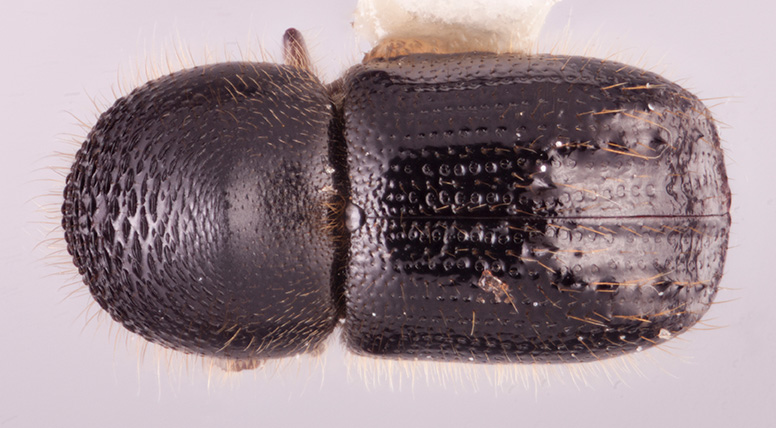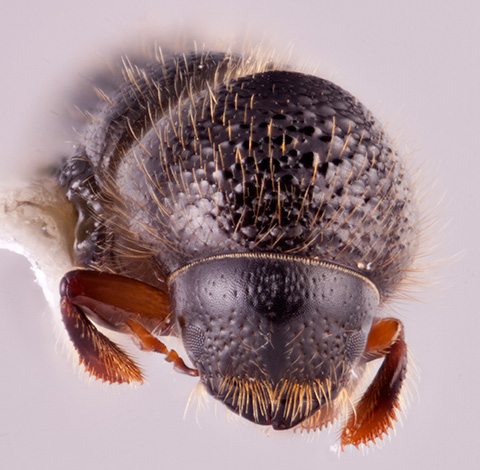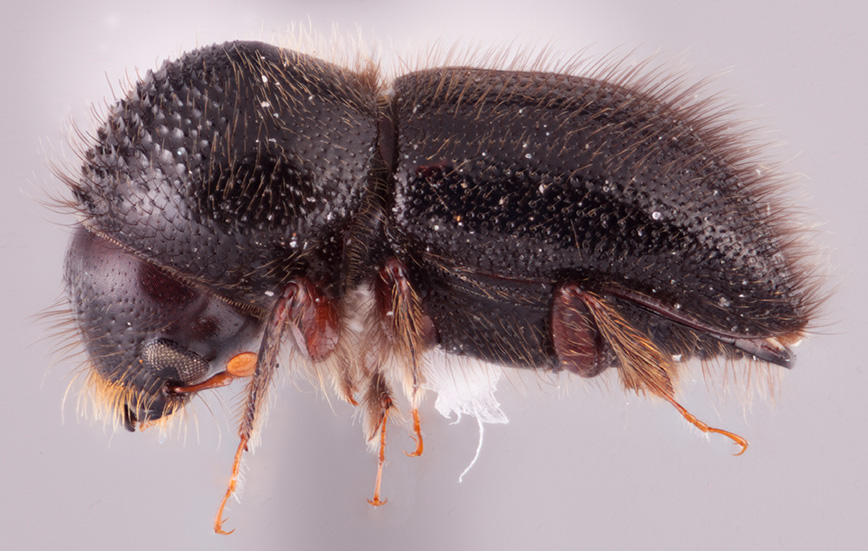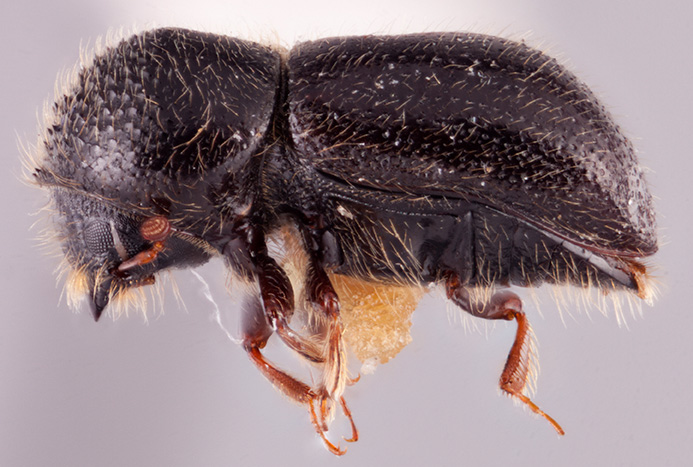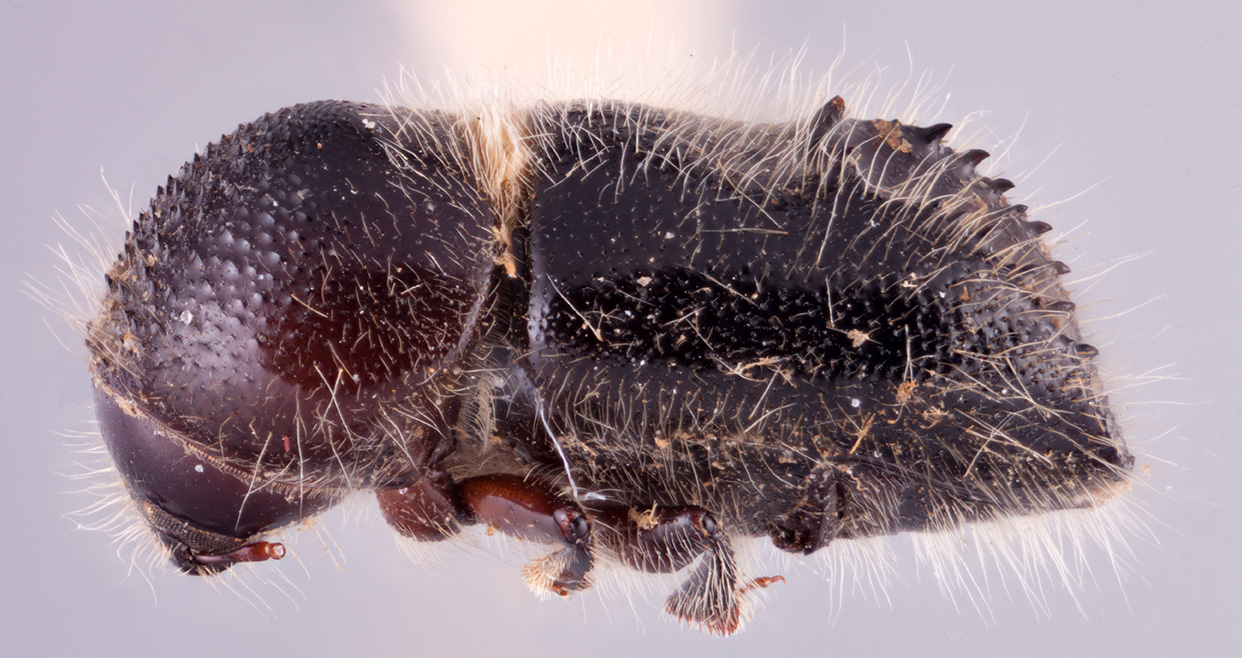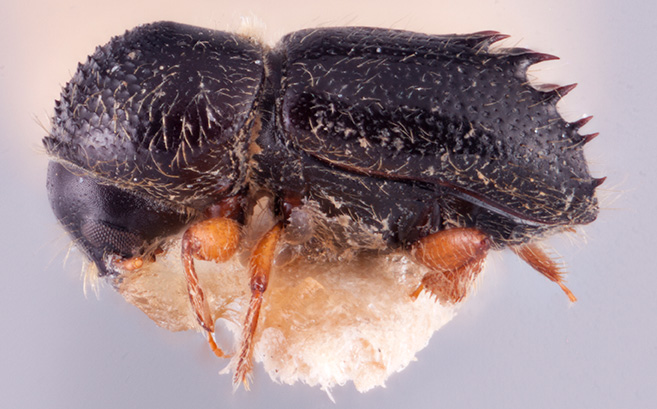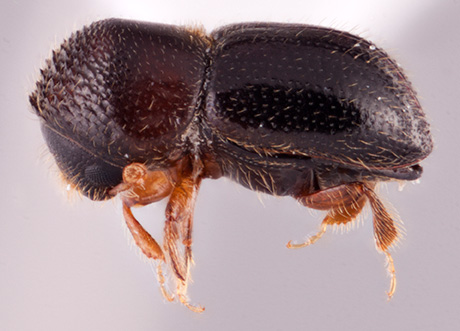Anisandrus
|
Anisandrus cristatus; R.K. Osborn |
|
Anisandrus cristatus; R.K. Osborn |
|
Anisandrus cristatus; R.K. Osborn |
|
Anisandrus cristatus; R.K. Osborn |
|
Anisandrus hirtus; R.K. Osborn |
|
Anisandrus dispar; R.K. Osborn |
|
Anisandrus klapperichi; R.K. Osborn |
|
Anisandrus percristatus; R.K. Osborn |
|
Anisandrus longidens; R.K. Osborn |
|
Anisandrus maiche; R.K. Osborn |
Taxonomy
Anisandrus Ferrari, 1867: 24.
Diagnosis
2.1−5.9 mm long, 1.88−2.78 times as long as wide, body usually stout and dark. Anisandrus can be distinguished most easily by the antennalantennal:
pertaining to the antennae
club type 1 (obliquely truncatetruncate:
appearing cut off or suddenly shortened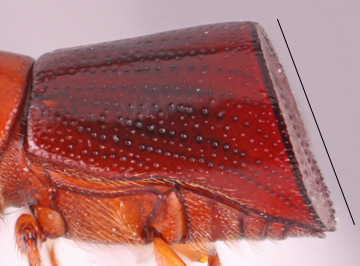 ) (A. achaete type 2); club taller than wide (A. achaete wider than tall); procoxae narrowly separated; protibia slender, distinctly triangular, outer margin with 5−8 large socketed denticlesdenticle:
) (A. achaete type 2); club taller than wide (A. achaete wider than tall); procoxae narrowly separated; protibia slender, distinctly triangular, outer margin with 5−8 large socketed denticlesdenticle:
a small tooth, the sides of which are equal and the tip is above the middle of the base on distaldistal:
on distaldistal:
situated away from the body
half, posteriorposterior:
toward the rear end; opposite of anterior
 face unarmed; mesonotal mycangial tufts typically present along the pronotalpronotal:
face unarmed; mesonotal mycangial tufts typically present along the pronotalpronotal:
pertaining to the pronotum
basebase:
point or edge closest to the body; opposite of apex (missing in three species), either as a small tuft the length of the scutellumscutellum:
(missing in three species), either as a small tuft the length of the scutellumscutellum:
a shield-like sclerotized plate located at the midpoint of the elytral base
and directly opposite it or extending laterally from the scutellumscutellum:
a shield-like sclerotized plate located at the midpoint of the elytral base
to striaestria:
punctures in rows, which may or may not be impressed to make grooves 3 and with elytralelytral:
3 and with elytralelytral:
pertaining to the elytra
basebase:
point or edge closest to the body; opposite of apex broadly, shallowly emarginated from the scutellumscutellum:
broadly, shallowly emarginated from the scutellumscutellum:
a shield-like sclerotized plate located at the midpoint of the elytral base
to striaestria:
punctures in rows, which may or may not be impressed to make grooves 3. Additional diagnostic characters include the pronotumpronotum:
3. Additional diagnostic characters include the pronotumpronotum:
the dorsal surface of the thorax
from dorsaldorsal:
of or relating to the upper surface; opposite of ventral
 view typically types 0 and 1 (A. cryphaloides, type 6), pronotumpronotum:
view typically types 0 and 1 (A. cryphaloides, type 6), pronotumpronotum:
the dorsal surface of the thorax
from laterallateral:
pertaining to the side
 view tall (type 3), or rounded and robust (type 5), anterioranterior:
view tall (type 3), or rounded and robust (type 5), anterioranterior:
the front or forward; opposite of posterior margin with a row of asperitiesasperity:
margin with a row of asperitiesasperity:
small flat denticle-like structures frequently arranged in rows or confined to specific areas
 or serrations; scutellum flat, flush with elytra; and the elytralelytral:
or serrations; scutellum flat, flush with elytra; and the elytralelytral:
pertaining to the elytra
discdisc:
the flat central upper surface of any body part (e.g. pronotum and elytra) either convexconvex:
either convexconvex:
appearing rounded or variously transversely impressedimpressed:
or variously transversely impressedimpressed:
a depression in a surface
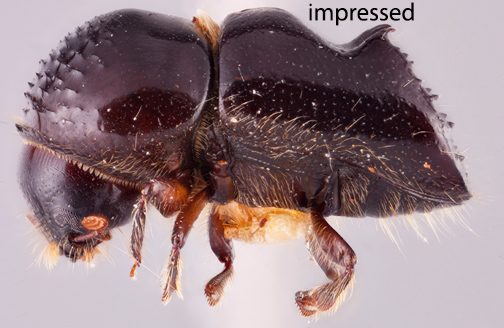 with a saddle-like depression. Species range from nearly glabrousglabrous:
with a saddle-like depression. Species range from nearly glabrousglabrous:
smooth, devoid of vestiture
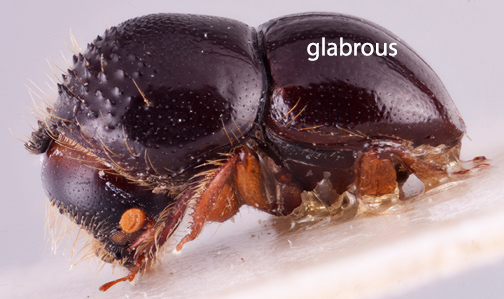 to densely setose and are typically black or dark brown.
to densely setose and are typically black or dark brown.
May be confused with
Cnestus, Cyclorhipidion, Hadrodemius, Xylosandrus. Anisandrus is closely related to Cnestus, Hadrodemius and Xylosandrus, all of which possess a mesonotal mycangium and the associated dense tuft of hairs at the scutellar area and pronotalpronotal:
pertaining to the pronotum
basebase:
point or edge closest to the body; opposite of apex (Gohli et al. 2017Gohli et al. 2017:
(Gohli et al. 2017Gohli et al. 2017:
Gohli J, Kirkendall LR, Smith SM, Cognato AI, Hulcr J, Jordal BH. 2017. Biological factors contributing to bark and ambrosia beetle species diversification. Evolution 71: 1258-1272. https://doi.org/10.1111/evo.13219, Johnson et al. 2018Johnson et al. 2018:
Johnson AJ, McKenna DD, Jordal BH, Cognato AI, Smith SM, Lemmon AR, Moriarty Lemmon EL, Hulcr J. 2018. Phylogenomics clarifies repeated evolutionary origins of inbreeding and fungus farming in bark beetles (Curculionidae, Scolytinae). Molecular Phylogenetics and Evolution 127: 229-238. https://doi.org/10.1016/j.ympev.2018.05.028).
Distribution
Uncommon genus with species occurring in forests of the Holarctic and Paleotropic regions with greatest species diversity in montane habitats.
Gallery system
The species usually attack stems of small diameter, and the gallery system consists of a radial or circumferential gallery with several longitudinal branches without brood chambers.
Remarks
This genus is remarkably diverse in montane habitats across Asia, but most species are poorly known. It is very likely that many new species await description.


